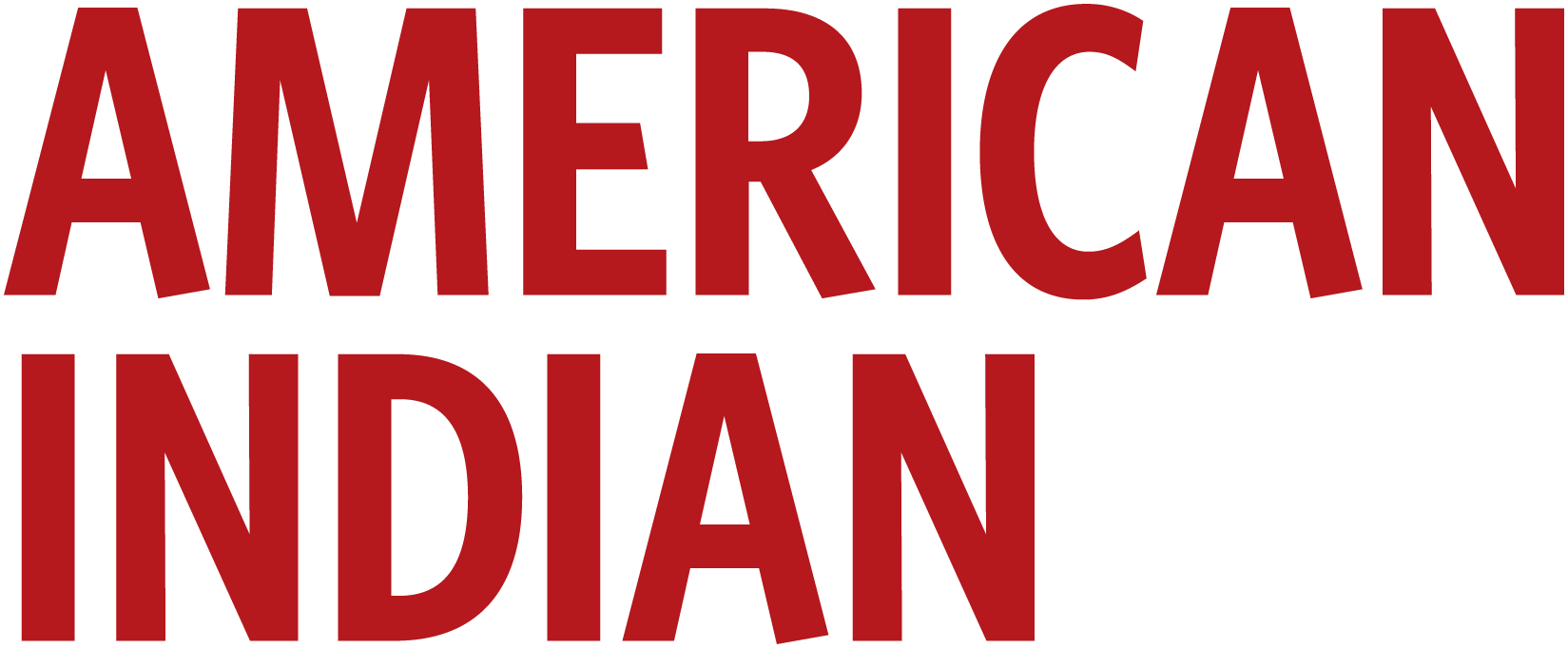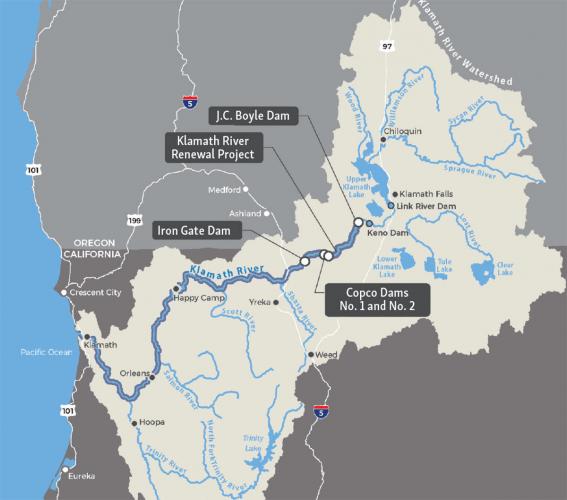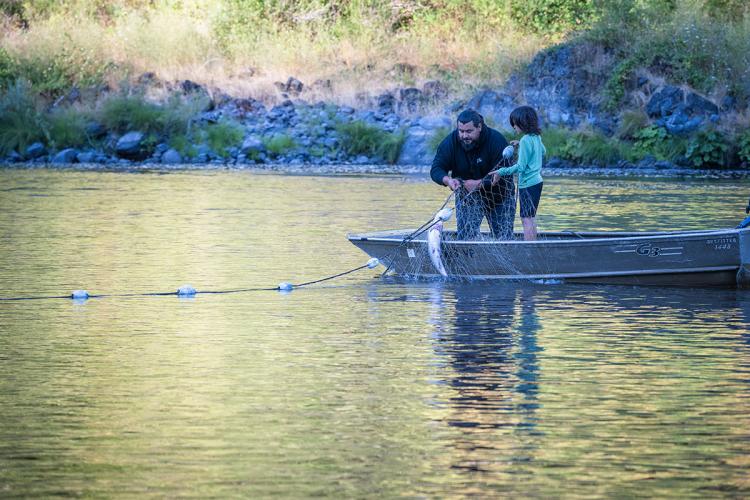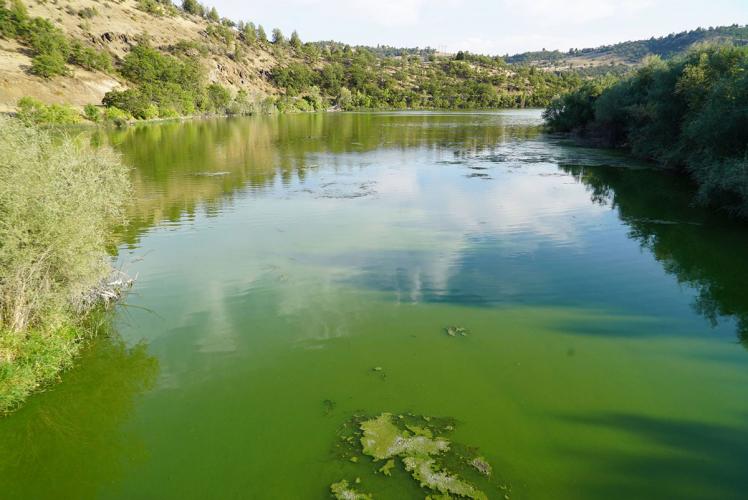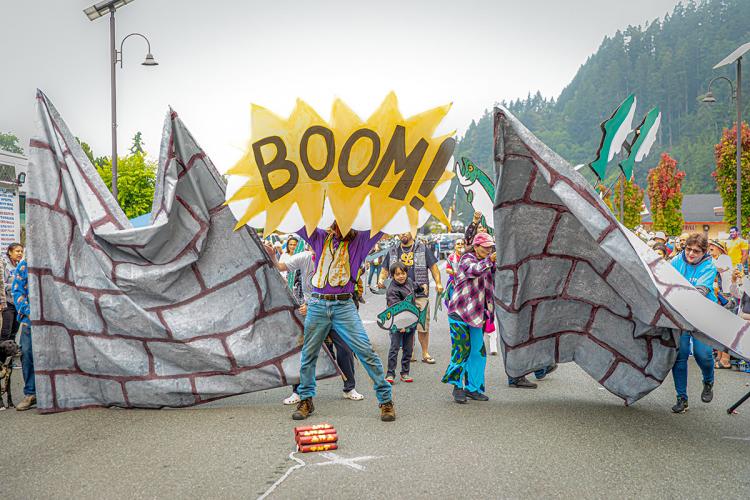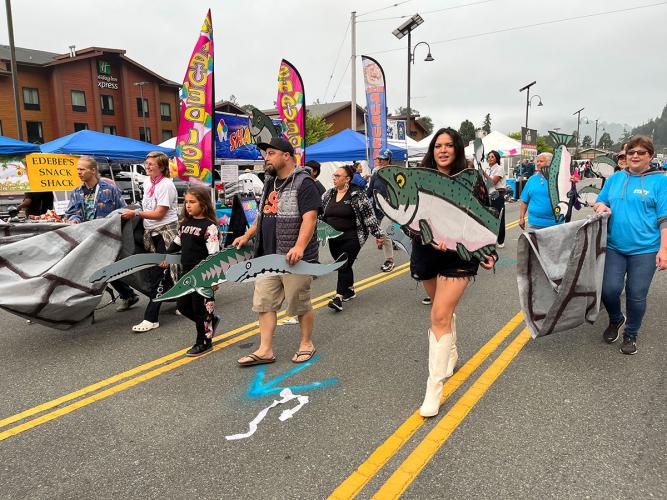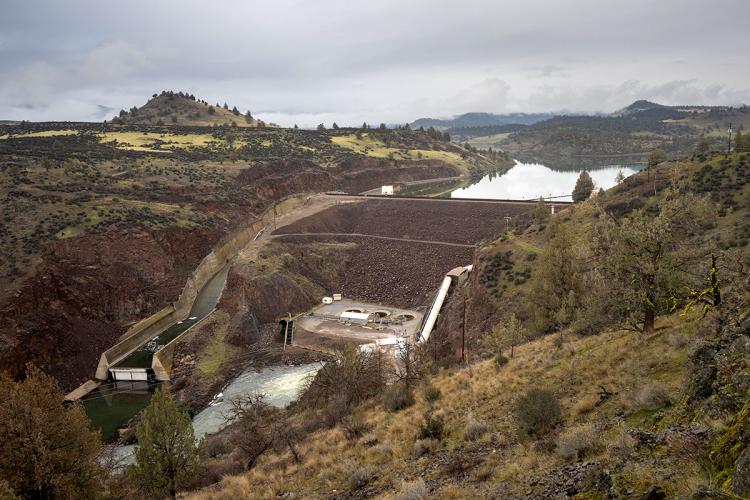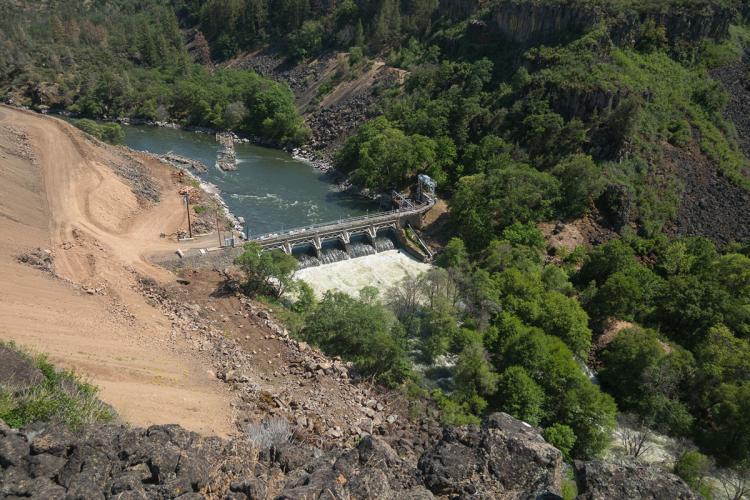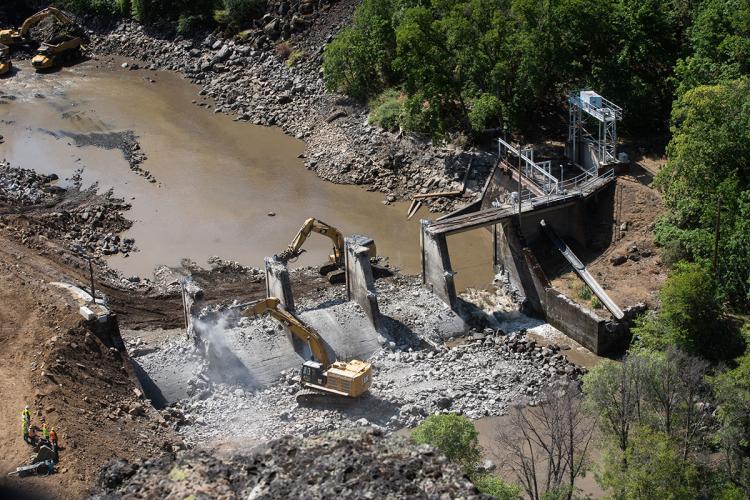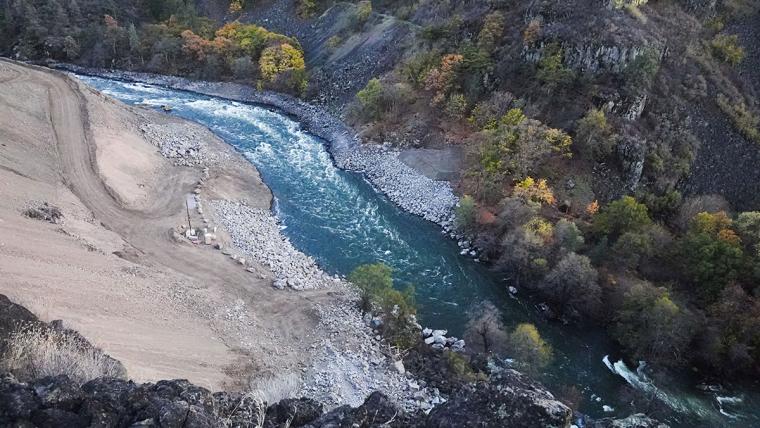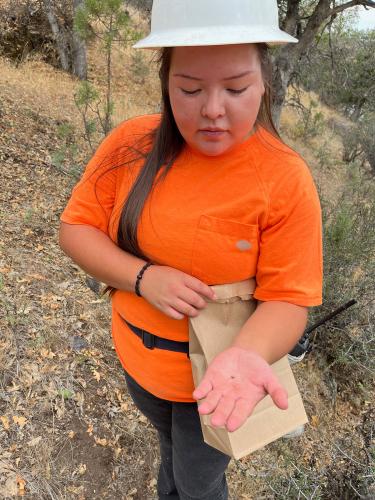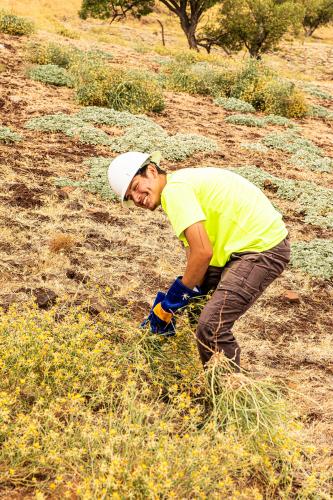This past August, about 15 miles upstream from the Pacific Ocean in California, the rocky shoreline of the Klamath River was sheathed in a haze of smoke drifting in from wildfires burning to the north and east. A pair of black bears in search of fish, berries and other food wandered onto the far bank. Minutes later, Yurok Tribe Vice Chair Frankie Myers launched a redwood canoe that he had carved from the nearshore. His young sons, Sre-gon and Re-wah, were onboard with him, and when they reached midriver, the boys leaped from the canoe into the water.
This stretch of river and its banks by the Yurok village of Surgone is a sacred site that Myers’s tribe uses for ceremonies. It was home to his father and other residents until it flooded in 1964. Over a lunch of half-smoked salmon pieces, macaroni and cucumber salads, Frankie and his wife, Molli Myers (Karuk), father, Richard (“Dickie”) Myers (Yurok), and other family and friends had gathered to celebrate the long-awaited removal of four dams from this 263-mile river that runs from Upper Klamath Lake in southern Oregon to the coast of California.
This $500-million-dollar project is the world’s largest dam removal effort to date. The first of the four dams, Copco No. 2 about 5 miles south of the Oregon border, was removed in September 2023 and the rest, Copco No. 1 and Iron Gate also in California and J.C. Boyle in Oregon, are expected to be demolished by the end of 2024. Led by the Klamath River Renewal Corporation and several American Indian tribes, they hope to restore the river’s natural flow that has been blocked since the dams were constructed between 1908 and 1964. This would open up more than 400 miles of spawning habitat along the river and its many tributaries to Chinook and Coho salmon and other fish and wildlife critical to the tribes.
Prime Salmon Habitat
The Klamath River and its 15,000-square-mile watershed has been home to the Yurok, Karuk, Hoopa Valley and Klamath tribes since time immemorial. Historically, it has been one of the world’s most plentiful salmon habitats; an estimated 880,000 fish traveled from the ocean upriver to spawn annually. However, after decades of water diversions, logging, mining, pollution from agricultural chemicals, suppression of cultural fire used to manage forest health (which produced smoke that cooled the river) as well as construction of the four dams that blocked fish migration, more than 90 percent of the salmon central to the tribes’ nutrition, traditions and religion are now gone.
“When I was a kid, there were still lots of fish,” said Dickie Myers, who recently celebrated his 80th birthday. “I was 10 years old when I swam across the river the first time with my mom. It was colder and had less moss covering it like a blanket.”
“You look in the [dams’] reservoirs, it’s bright green from the algae,” said Molli Myers. When the dams are removed, “The natural flow of the river will flush the moss and parasites out of the river,” she explained. “At our heart is always our river and our fish.”
The decline of the Klamath salmon culminated in a historic die-off of more than 70,000 fish in 2002. Despite warnings from scientists, farmers in Oregon illegally diverted water from the river during a drought. The George W. Bush administration sided with the rogue irrigators, sending Secretary of Interior Gale Norton to officiate as more water was diverted from the river’s upper basin. “We protested, but we were outnumbered,” recalled Molli Myers. “And they were on horseback with rifles, and we had drums. … We said ‘This will kill our fish,’ and then a short time later, we had dead fish.”
The 2002 fish kill renewed efforts of the tribes and local organizations to restore the river. Realizing PacifiCorp, the company that owned the dams, was up for relicensing in 2004, they launched the Bring the Salmon Home campaign, calling on the company to surrender the dams. At the time Pacifi-Corp was owned by a Scottish company, and for the first time in 2004, a delegation of 30 tribal members from the Yurok, Karuk, Hoopa and Klamath tribes traveled to its shareholders’ meeting in Edinburgh. They met with people interested in the river’s future, the media, politicians and London bankers to pressure the company to respect their home river. “The CEO of the company said, ‘We don’t need an agreement here. We do things with a handshake,’ and he shook my hand,” Dickie Myers recalled.
But then in 2006 PacifiCorp was sold to Berkshire Hathaway, a company founded by billionaire businessman Warren Buffett. The protests shifted to its shareholder meetings in Omaha. At the same time the company looked increasingly likely to lose money if it had to comply with requirements for fish ladders and human safety measures that needed to be added to the aging dams.
After years of negotiations with farmers and water districts, with funding from PacifiCorp and the states of California and Oregon, the company agreed to a final settlement in 2016. In 2022 the Federal Energy Regulatory Commission (FERC) granted approval for the dam removals, and the license and ownership of the dams was transferred to the Klamath River Renewal Corporation (KRRC) and the river’s two states. KRRC is a nonprofit organization with tribal representation on its board, which has been overseeing removal of the dams and river restoration efforts.
“The Klamath is one of the few rivers that you can restore from top to bottom,” noted Jeff Mitchell (Klamath/Modoc), chairman of the Culture and Heritage Committee for the Klamath Tribes. He lives by the Klamath River’s headwaters in Oregon and worked with other tribes to negotiate funding from his state for the removal of the dams. “We’re all fish people. We’re all water people,” he explained. “Our culture is a little different with each tribe, but because of our solidarity, we achieved the goal. At one point, it was just the four tribes and one environmental group, Friends of the River, that stuck with the tribes and everyone else said let’s settle for something less. But we couldn’t do that. We’d be turning our back on the fish and future generations.”
Past dam removals—including one on the Kennebec River in Maine in 1999 and another on the Elwha River in Washington state in 2011—have led to remarkable recoveries of biodiversity and ecological health for those river systems, such as increased fish spawning. According to NOAA Fisheries, for example, annual runs of alewife herring on the Kennebec and its tributaries have grown from near zero to more than 5 million fish.
Celebration
Last August, the Yurok’s 59th annual Klamath Salmon Festival took place near the wide mouth of the Klamath River and its tidal estuary in Klamath, California, where gray whales sometimes linger in the coastal fog. For the second time in nearly six decades, no salmon from the Klamath could be served at the festival. Following years of drought, too few fish returned to spawn in 2023 and the state and tribes agreed to close the salmon fishing season.
Despite the lack of salmon and the prevalence of wildfires generating thick smoke and precautionary power outages in the area, the mood was still festive. Several thousand people turned out to celebrate the dams’ removal on the street facing the Yurok’s tribal office in Klamath. The gathering featured a 3-mile race and stick games as well as a basket weaving exhibition, bounce slides and ponies for the youth, and booths with food, crafts and information, including one about the Yurok Condor Restoration Project.
“The condor carries our prayers for World Renewal,” explained the tribe’s Wildlife Director Tiana Williams (Yurok). “And if we get the river back in shape, we’ll get back the salmon they once fed on.” The project has already released and tracked 11 California Condors, the largest bird in North America, and anticipates releasing up to seven more in 2024.
The parade started at 10 a.m. with an honor guard of Indian veterans and Yurok Tribal Council Chair Joe James and Frankie Myers tossing candy to the crowd. Among those following them were floats, two marching bands, a fire engine and two big trucks from the “Cultural Fire Management Council.” This was followed by a big gray curtain being carried on poles and painted as a dam with cardboard fish heads bobbing in distress above its top. A man stepped out in front of the curtain and opened a big jagged yellow cardboard sign that read “BOOM,” and the cloth dam fell down. A happy squadron of children and adults holding painted salmon, sturgeon and lampreys surged forward, met with cheers and applause from the crowd.
“We used to do that as theater as part of our protests. But seeing it in the parade and knowing it’s really happening, I get choked up,” said Frankie Myers, who was enjoying the festival with Molli and their sons.
Later the festival hosted a “Rez Chop Competition,” a cooking contest. Winner Amber Gensaw (Yurok) made Buffalo Veggie Stir Fry. She’d recently moved back to the reservation and the town of Requa where she grew up so her 3-year-old son and 1-year-old daughter “can go to a school where they’ll learn to speak Yurok and grow up in their culture,” she said. “To me, our language and salmon make us who we are. Salmon is our life and our world.”
Her brother, Sammy Gensaw (Yurok) has been a salmon activist since he was 14. Now 30, he said that, “I’m a born and bred salmon fisherman. Usually, our family goes through 30 cases of smoked salmon in a year, and this last year it’s just been a few jars to get us through. With the [wildfires,] the hunting season has also been cut short. So, all our ways to provide for the family are at risk,” he added. “I’ve spent half my life dedicated to dam removal. A healthy river is what I’m willing to die for because our river provides for every person I love.”
About 75 miles upriver in the unincorporated community of Orleans, dozens of fire fighters and their trucks are parked by the elementary school, waiting to be deployed. Leaf Hillman (Karuk) leaned over his dining room table and looked at a topographical map while talking to a cultural liaison from his tribe. They were tracking wildfires in the surrounding hills, including one that had grown to 1,000 acres, while reviewing a list of planned ceremonies that might have to be delayed due to the fires.
A former Vice Chair and Natural Resources Director of the Karuk Tribe, Hillman is also a ceremonial leader during Piky’avish, the Karuk World Renewal Ceremony. He was wearing a traditional Karuk basket hat of woven grasses and porcupine quills made by his wife, Lisa Hillman, a master weaver. Bundles of bear grass covered the kitchen counter and were gathered into a cardboard box on the floor. “She’s got so much work, I gather the materials for her. So, turns out I’m a full-time Indian hunter and gatherer,” he said with a grin.
“Our religion is not ‘faith-based.’ It’s proactive,” he explained. “My life has been to bring back the World Renewal Ceremony…. The priest will fast, pray, go to the mountain from the sweat house and when people see him again [on his return] he bellyflops into the creek and those waves send prayers to the salmon telling them it’s time to come home. You do things to create more salmon. If we quit fighting for them, they’ll stop coming. So, we have to work freeing the river and taking the dams down. We’re doing it for our Spirit People Kin so they can take care of us.”
Restoration
More than 120 miles farther east on a narrow, twisting road, the Klamath River runs sluggish, garlanded in mats of green algae. The river meanders through high desert under the watchful eyes of ospreys and eagles until it reaches the Iron Gate Dam about 25 miles northeast of Yreka, California. Built in 1962, this goliath earthen structure, the largest of the four dams, is 173 feet high and 540 feet across.
Before this dam can be removed, its waters will be diverted into a temporary channel. Its 1,000-acre reservoir will then drop a few feet a day. When it reaches the level of the original river channel, the exposed sediment will be replanted with native grasses, wildflowers, bushes and trees. During the past several years, 17 billion seeds have been collected and propagated in nurseries for just this purpose. In total, some 2,200 acres of drained reservoir lands behind all of the demolished dams will be replanted, restoring habitat for fish and wildlife. The plants will provide good forage for land animals, keep sediment from sliding into the river and shade the river, keeping its temperature cool enough for spawning salmon, steelhead and other fish to thrive.
In a dirt parking lot adjacent to the dam, a couple of trucks pulled up with restoration crews from the Yurok Fisheries Department in white safety helmets and bright orange and lime-colored shirts. Their work is overseen by Resource Environmental Solutions, a contractor of KRRC responsible for post-dam restoration work that the corporation is funding for the next decade. The Yurok Tribe has committed to restoring the area. The crew of mostly young tribal members work four-day weeks, 10 hours per day out of a tribal owned house in the Copco Community.
“It has a pretty view of the lake, but soon it’ll be a view of the river with all our plants,” said Alauna Grant (Karuk), who was leading a team of “seed collectors.” The other “invasives crew” removes non-native plants, which cover 90 percent of the area, mowing back cheat grass and medusa head and pulling out yellow star thistle, blackberry, poison hemlock and other plants by hand. They call it “mowing and grubbing.”
Grant started with some milkweed, putting its seed fluff in a paper bag, then worked her way around the wet reedy edge of the reservoir and up a golden hillside under cloudy skies. Inspecting a white oak tree, she remarked, “It’s producing really well. Acorns will be ready in September.” She then marked its coordinates on her phone.
She climbed higher through hills of pine, scrub oak and buck brush. She admitted to having a few favorite species such as chaparral honeysuckle “whose ripe berries are like little water balloons,” and Lomatium californicum, “They burn the root in ceremony and it has a nice sweet aroma.” She moved higher up to look for rare black oak.
A while later back at their truck, her team member Mikayla Logan (Yurok) showed some ripe, nearly black acorns. “I feel like the deer and squirrels are going to beat us to it.” They load a big plastic bin with their sample bags for sorting and weighing back at the house.
Several miles down a rutted and potholed road, the invasive species team’s work is visible near the water where a cleared strip is being naturally reclaimed by native lupine, croton, dove weed and sunflowers. The team of four had already cleared most of an acre of thistle that was now piled up along an earth-brown slope.
Among them is Shea McDonald, a restoration ecologist in his third season of leading field operations for the Yurok Tribe’s revegetation program. His experience includes extensive field work he carried out on the Elwha Dam removal in Washington state, where he was raised.
Rodney Virgil III (Yurok) is also on the team. He yanked hard at a big spiky thistle bush to pull its tap root out. “I heard about the dams my whole life from my parents, so I got into it for the river and for my people. My folks are real proud of me,” he said with a radiant grin.
Closer to the reservoir, Terrance McCovey (Yurok/Karuk), is two decades older, with a family in nearby Yreka. “I’ve been on the Klamath my whole life hunting and fishing, so my motivation is to get the river healthy. The salmon haven’t come up here for 100 years, but now they will. It’s good work but tough. I’ve had my arms bleeding [from pulling the spikey thistle].”
“The Creator’s work don’t come easy,” his father, Chemooch McCovey (Yurok/Karuk), said while yanking up another bushy star thistle. “Working here with my son is a blessing. The river is the heart of our culture so once the healing process begins that will be pleasing to the ancestors. We might be the only tribes to pray for the balance of the Earth,” he added, “and we need hope in our lives to understand how delicate and precious this Earth is. Luckily about now Western science is catching up with stuff we knew for millennia, and that’s good.”
Like many other tribal members, Chemooch McCovey was involved in the fight to take down the dams. “We persevered when it looked grim and bleak,” he said. “After the dam removal, it’ll probably be a couple of years for the fish. But that I can see this in my lifetime… .” He paused and shook his head in wonder before pulling out another bush.
“My biggest hope is that we can bring back the Salmon Ceremony after the healing starts, and we’ll try and revive that ceremony that the Yurok and Karuk and Hoopa shared,” he said looking out to where the reservoir’s green algal waters still hide the river. “When the first fish came all the way up the Salmon River, they sent runners down to Requa to let the Yuroks know that they can start to fish because everyone, all of the tribes, now have salmon.”
